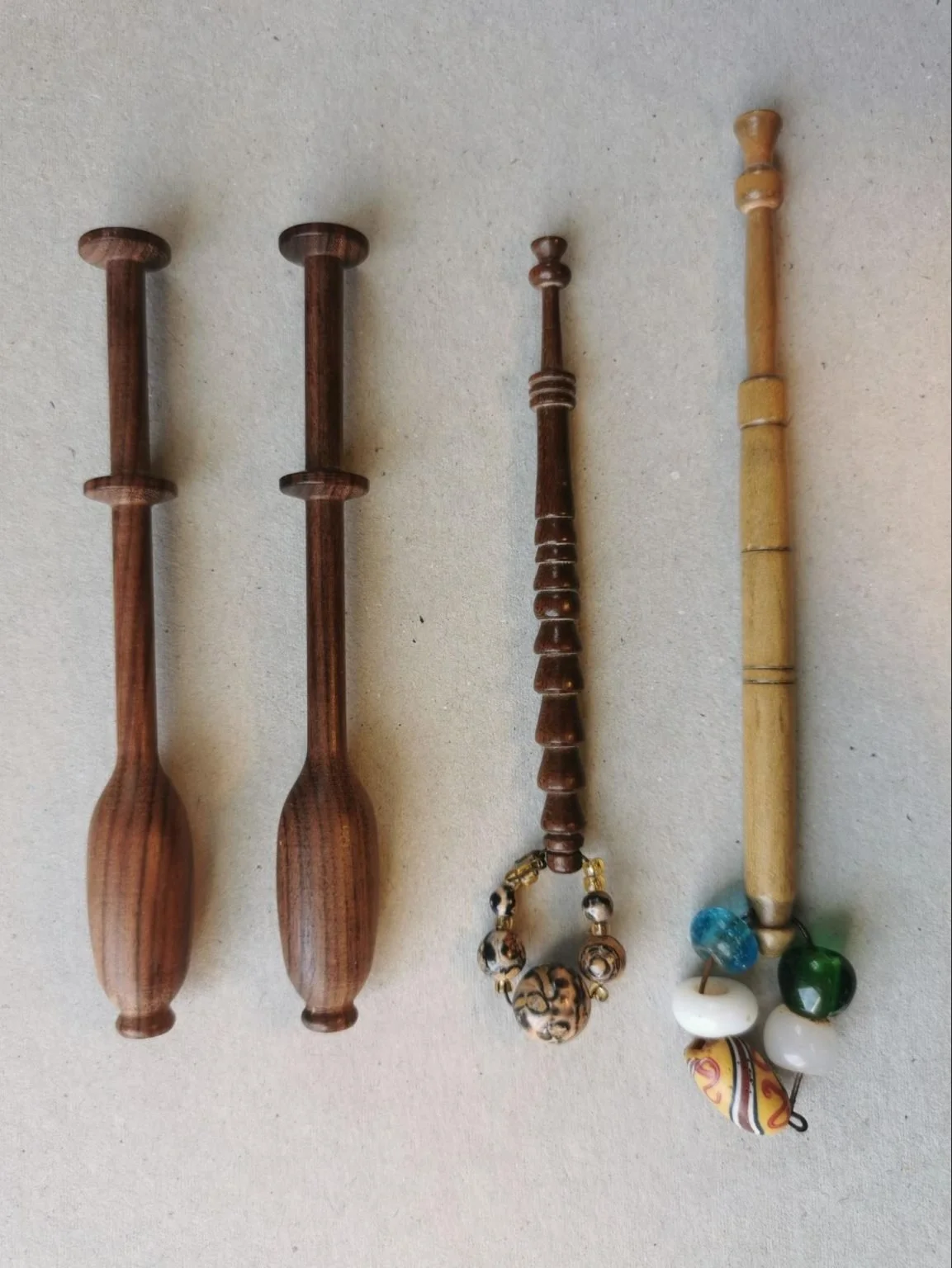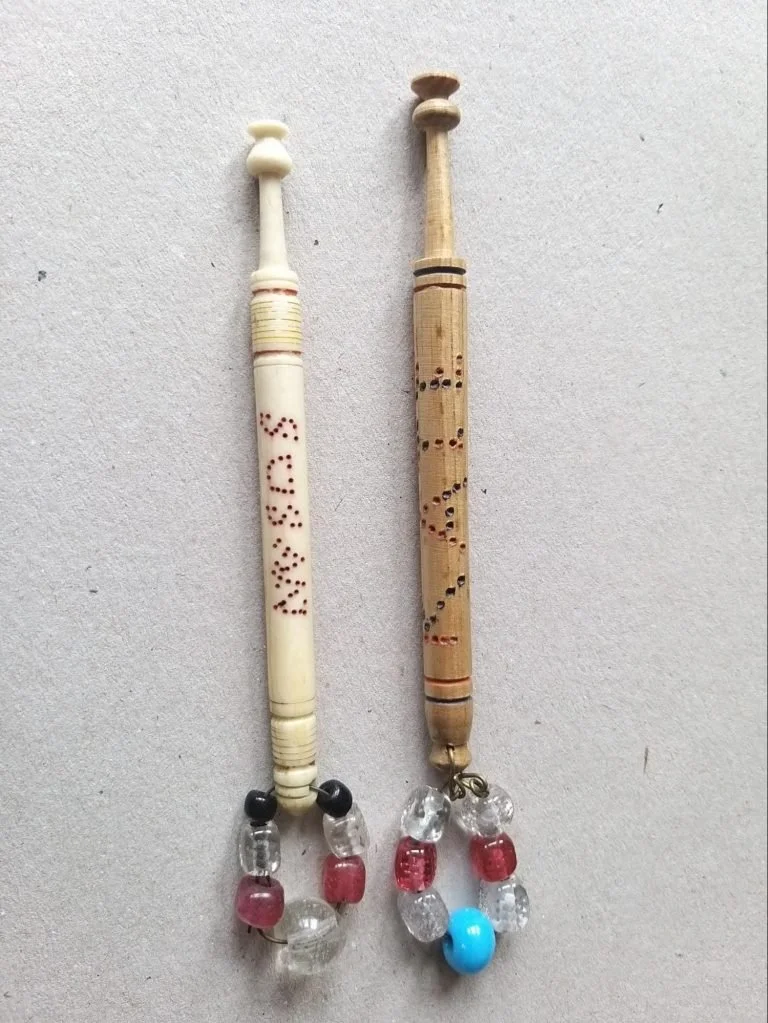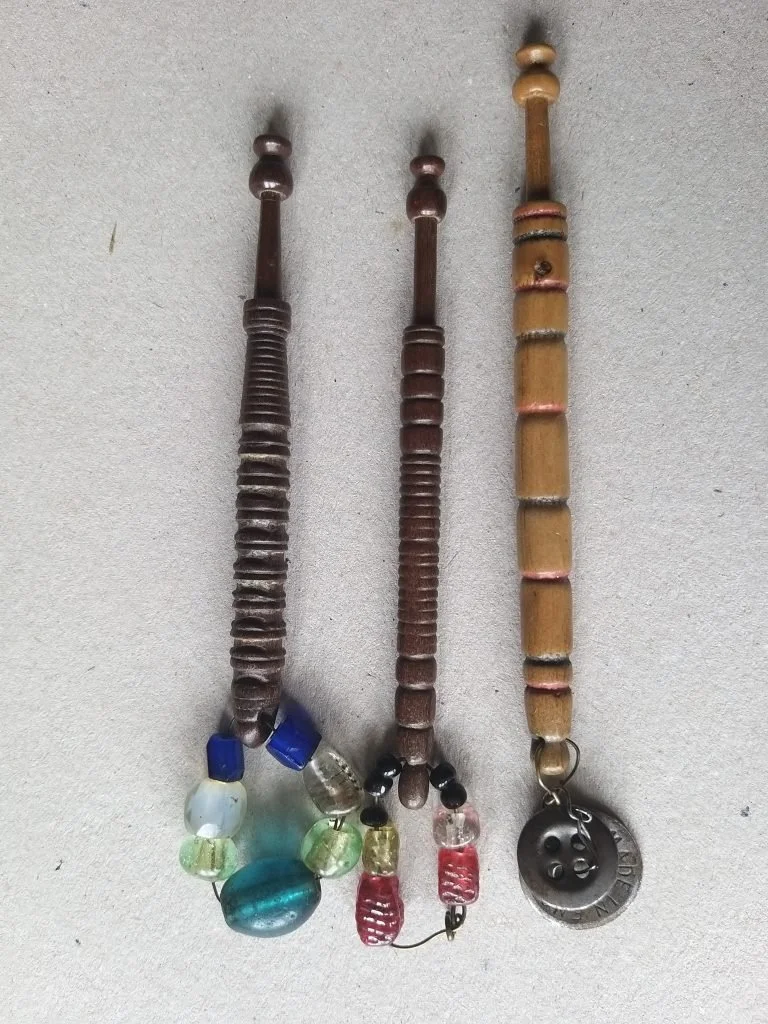Lacemakers Tools and Superstitions around them
Bobbin Lace is a type of lace made by twisting and plaiting threads using bobbins – small sticks usually made from wood – which are used to weave them together. This weaving is held in place by pins, the position of which is usually determined by a pattern or pricking, onto a pillow. The pillow was traditionally stuffed with straw, though nowadays polystyrene is more often used.
Bobbins
Bobbin lace is also known as bone lace. This is, as far as I know, because early bobbins were usually made from bone or ivory. Although bone bobbins are still used, it seems far more common for lace-makers to use wooden bobbins. This may be because they are heavier, and so better for keeping tension on the thread.
I have been exploring lace bobbins and their bead spangles, mostly by reading articles by Nicolette Makovicky and The Romance of the Lace Pillow” by Thomas Wright among others. I have listed all my references at the bottom of this post! I have discovered through my reading that different geographical areas appear to have their own particular style of bobbins. Continental bobbins tend to have a larger bulbous handle which weighs them down, putting tension on the thread and making them easier to manipulate.
Whereas, it seems, lacemakers in continental lace making areas such as Flanders, Belgium and France used matching identical bobbins on plain wood, it appears that English lace-makers used a wide variety of mismatched bobbins on their pillows.
Honiton bobbins from Devon are straight and finish in a point. Bobbins from the East Midlands were traditionally very slender, light and straight, and needed to be “spangled” to weigh them down. Spangles are a ring of beads at the bottom of the bobbin. They add a decorative element to the bobbin, add weight to create tension and also keep the bobbins in the right place on the pillow, to stop them rolling off and getting tangled. The beads were specially made for spangles – often with a rough texture and with a scored finish to create grip. However, these beads were expensive, so lacemakers would sometimes buy penny necklaces from fairs to make their own spangles. They would also thread charms, buttons, shells and coins onto their spangles, which often had sentimental or superstitious value. More about the superstitions and beliefs about spangles in a later post!
Inscribed bobbins – morbid mementoes
Bobbins made of bone were sometimes inscribed. Many of the inscriptions found on the bone bobbins commemorate births, marriages and deaths. Inscribed bobbins were also popular love tokens from young men to their sweethearts.
Inscriptions also include marriage proposals, quotes from scripture, or significant birthdays. The penchant for inscribed bobbins was also exploited for political and commercial gain: Bobbins bearing the names of political candidates were given out at election time and some lace dealers were also known to gift lace makers with bobbins in order to secure their loyalty. One of the most fascinatingly dark things I have heard about commemorative bobbins is that they were also sold at executions: “hanging bobbins” were inscribed with the name of the criminal and the year of the execution, and were extremely popular souvenirs!
I have also read that girls would have also been told that if she worked hard at her lace pillow, she would be allowed to go and watch the hanging as a treat.
Pins
Bones as pins
I read in F.B Palliser’s Victorian book on lace history that, in Devon, lacemakers used fish bones as pins, being mainly the wives of fishermen living along the coast. I asked Professor David Hopkin about this and he said that he hadn’t heard of this but that, due to the expensive nature of handmade metal pins, it is possible that people did use bones as pins. In Mrs Palliser’s book, there is also mention of chicken bones being used in Spain at the time of her book writing (1975).
Thorns as pins
I read in an article by Julia Brussi (a guest writer on the Lace in Context blog) that thorns are used as pins by lacemakers today in Canaan, Brazil. The thorns are taken from a cactus and are found to be more advantageous than metal pins – being cost free and not rusting in the salty air, avoiding the risk of staining the lace.
The History of Lace, Mrs B. Palliser, Third Edition, 1975
Professor David Hopkin – interview 24/5/2021
https://laceincontext.com/the-lacemaker-and-the-household-in-canaan-brazil/
Spangles
The practice of adding “spangles” (rings of coloured beads) to the ends of bobbins (the East Midlands ones in particular) seems to be a unique trait of English bobbin lace makers. I wondered why the East Midlands style of bobbin had the added spangle, and not the pointed-ended Devon bobbin. I have since learnt that Devon lace traditionally required finer thread, and also the ability to pass the pointed end of the bobbin through loops of thread, thus the spangle would have encumbered this.
I have also discovered there are many superstitions and beliefs surrounding the beads used for lace makers’ spangles. I found a fascinating little book called Spangles and Superstitions by Christine and David Springett. The following information on this post was learnt from that book.
Glass beads would have been used to decorate the spangles, being easily obtained and adding colour and sparkle, but also other trinkets too. These objects were chosen purely for their required weight, but more often than not, for their personal significance to the lace maker. As quoted in Spangles and Superstitions: “…such as a shell brought back by a sailor in the family or as a souvenir of a rare trip to the sea, sometimes a button from a fiance’s waistcoat, or even a fob from the watch chain of a loved one.”
I have included a photo of some lace bobbins I found on eBay, one of which has two buttons on its spangle, rather than beads.
“Eye” Beads: Protection against the Evil Eye
Some beads were made with spots added to them in a contrasting color, to represent an eye. It is believed that lace makers would make sure there was a particular type of bead somewhere on their pillows, an “Eye” bead, to keep away the “evil eye” and to keep an eye on the lace, to avoid costly mistakes in their lacemaking. These beads could be “Serpents Eye” beads, or “Evil Eye beads”. These combined the spiralled line of the snake encircling the bead with a spot representing the “eye”.
Buttons
A bunch of buttons at the end of a spangle was supposed to give the same effect as an Evil Eye bead. It was considered wise to have buttons on bobbins at work on the lace pillow as protection against the evil eye, avoiding mistakes!
Particular types of buttons can also have personal significance for the lace maker. As quoted in Spangles and Superstitions, “when a lace maker became engaged she would use her fiance’s waistcoat button to spangle a bobbin inscribed with their names. On the other hand, a trouser button had a very different meaning! Should a spinster who was previously considered to be “on the shelf” finally manage to catch herself a husband, then her lace making “friends” would take an ‘old maid bobbin’ (very thin and plain!) and spangle it with a single trouser button! A subtle comment indeed!”
Wooden Beads
A bead made from the wood of a yew tree was believed to protect the owner from accidents.
Leopards
Leopards are bobbins from either bone or wood inlaid with spots of pewter. In the Bedford area it was believed that leopards would protect the lace maker from arthritis and rheumatism.
To learn more about spangles and superstitions and beliefs about them, see Spangles and Superstitions by Christine and David Springett, and The Romance of the Lace Pillow by Thomas Wright.





